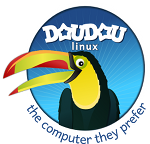DoudouLinux
 DoudouLinux Logo | |
 Screenshot of the main screen with the program "Marble" being launched | |
| OS family | Unix-like |
|---|---|
| Working state | Discontinued[1] |
| Source model | Open source |
| Initial release | May 2010[2] |
| Latest release | 2.1 / December 2013[3] |
| Marketing target | Children |
| Available in | 44 languages[3] |
List of languages Arabic, Armenian, Bengali, Burmese, Chinese (China and Taiwan), Croatian, Czech, Danish, Dutch, English, Esperanto, Finnish, French, Galician, German, Greek, Hebrew, Hindi, Hungarian, Indonesian, Italian, Latvian, Lithuanian, Luxembourgish, Malay, Marathi, Norwegian (Bokmål and Nynorsk), Persian, Polish, Portuguese (Brazil and Portugal), Punjabi, Romanian, Russian, Scottish Gaelic, Serbian, Spanish, Swedish, Tajik, Telugu, Turkish and Ukrainian. | |
| Influenced by | Debian |
| Default user interface | LXDE[4] |
| License | GPLv3[5] |
| Official website | doudoulinux |
DoudouLinux is a discontinued Linux distribution based on Debian[6] intended for children as young as 2 years old.[4] DoudouLinux is named after the French word doudou which refers to a wubby, which is a comfort object such as a small blanket or a teddy bear.[7]
DoudouLinux has not received an update since 2013, and their website has not received an update since a 2015 blog post.[8]
Features
[edit]

Versions 1.x are referred to as Gondwana, and versions 2.x are referred to as Hyperborea.[7]
DoudouLinux uses a heavily modified version of the LXDE as its desktop environment, which is intended to be as simple for children to use as possible.[9][4]
DoudouLinux comes with software including the GCompris suite, which includes educational software and games. It also includes another package of children's games called Child's Play, as well as several educational KDE Applications.[9]
DoudouLinux's web browser Ephiphany[10] comes installed with a web filtering tool called DansGuardian and uses DuckDuckGo by default[9]
Version 2.1 has software used to monitor computer use.[3]
Minimum configuration
[edit]According to DoudouLinux's documentation, the minimum recommended configuration has three requirements: 256 MB memory, an 800 MHz processor, and an 800×600 dots display.[11][9]
Reception
[edit]Reviews by PCMag[9] WebUpd8.org[12] focused on the simplicity of the software interface and its ease of use for children.
Reviews by ILoveFreeSoftware.com[10] and MakeTechEasier.com[13] focused on the educational games provided by DoudouLinux.
A review by Unixmen.com focused on the updates of the 2.0 release which included a UI overhaul and security updates,[6]
A Spanish review by Mundiario.com[14] focused on the installation process of DoudouLinux, while an Italian review by Altreconomia.it[15] reviewed the distro's focus on children as well as the background of an Italian company that makes use of DoudouLinux on computers.
References
[edit]- ^ "DoudouLinux". DistroWatch. 7 February 2022. Archived from the original on 6 July 2022. Retrieved 26 August 2022.
- ^ "Release notes". DoudouLinux.org. November 2013. Archived from the original on 30 January 2020. Retrieved 27 August 2022.
- ^ a b c "What's new in the latest release?". DoudouLinux.org. December 2013. Archived from the original on 21 June 2022. Retrieved 27 August 2022.
- ^ a b c Hertzog, Raphaël. (2015). The Debian administrator's handbook : Debian Jessie from discovery to mastery. [Sorbiers]: Freexian Sarl. p. 445. ISBN 979-10-91414-04-3. OCLC 943280037.
- ^ "The DoudouLinux source code". DoudouLinux.org. March 2010. Archived from the original on 12 March 2017. Retrieved 26 August 2022.
- ^ a b Nyamador, Enock Seth. "Introducing Kids to Linux Using DoudouLinux". Unixmen.com. Archived from the original on 26 August 2022. Retrieved 26 August 2022.
- ^ a b "The DoudouLinux origins". DoudouLinux.org. September 2010. Archived from the original on 28 September 2020. Retrieved 26 August 2022.
- ^ Sjölund, Jimmy (4 September 2017). "What's the current state of Linux distros for kids?". Opensource.com. Archived from the original on 19 October 2021. Retrieved 26 August 2022.
- ^ a b c d e Rashid, Fahmida Y. (30 April 2014). "DoudouLinux Review". PCMag. Archived from the original on 26 August 2022. Retrieved 26 August 2022.
- ^ a b Jayakumar, Shine (2 December 2013). "Free Linux For Kids: DoudouLinux". ILoveFreeSoftware.com. Archived from the original on 26 August 2022. Retrieved 26 August 2022.
- ^ "Download". DoudouLinux.org. November 2013. Archived from the original on 30 June 2020. Retrieved 26 August 2022.
- ^ Ireena (5 January 2011). "DouDouLinux: A Linux Distribution Especially Designed for Kids". WebUpd8.org. Archived from the original on 26 August 2022. Retrieved 26 August 2022.
- ^ Damien (26 November 2010). "DoudouLinux: A Fun Linux Distro For Kids". MakeTechEasier.com. Archived from the original on 26 August 2022. Retrieved 26 August 2022.
- ^ Lareo, Fran (11 May 2015). "DoudouLinux se populariza como una distribución linux para los más pequeños" [DoudouLinux becomes popular as a Linux distribution for children]. Mundiario.com (in Spanish). Archived from the original on 26 August 2022. Retrieved 26 August 2022.
- ^ Bizzini, Francesco (1 November 2012). "DouDouLinux, il software libero a portata dei più piccoli" [DouDouLinux, the free software within reach of children]. Altreconomia.it (in Italian). Archived from the original on 28 September 2021. Retrieved 26 August 2022.